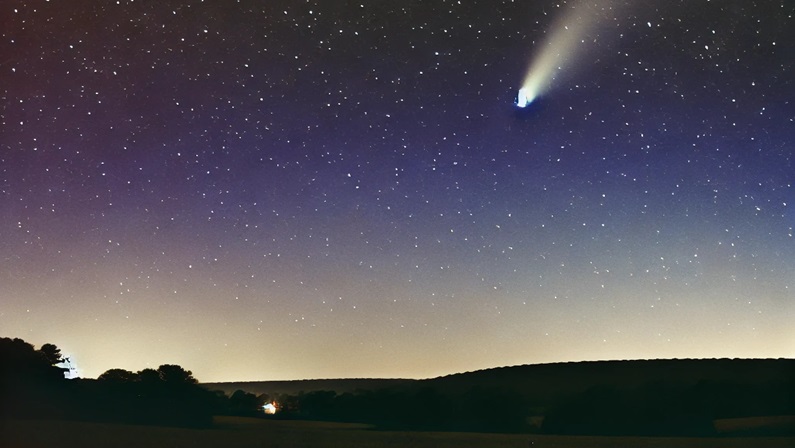This week only, you have the chance to witness something truly extraordinary — a celestial visitor that won’t return for another 80,000 years. To catch a glimpse, all you have to do is look up.
Comet Tsuchinshan-ATLAS (“Comet A3” for short) is lighting up the Connecticut night sky, offering a once-in-a-lifetime spectacle that you won’t want to miss.
Whether you’re a seasoned stargazer or simply curious about the cosmos, this rare event is the perfect reason to head outside and gaze at the stars for a once-in-a-lifetime show.
What Is Comet Tsuchinshan-ATLAS?
Discovered in early 2023 by astronomers at China’s Tsuchinshan (Purple Mountain) Observatory and South Africa’s ATLAS telescope, Comet C/2023 A3 Tsuchinshan-ATLAS hails from the Oort Cloud—an icy shell of objects surrounding the solar system.
This enormous space traveler stretches two miles in diameter, while its dust and gas tail spans millions of miles, creating an unforgettable sight as it passes by Earth.
What makes this event even more thrilling is that the comet won’t return for another 80,000 years. That means this is a true once-in-a-lifetime opportunity to catch a glimpse of it.
When and How to See It in Connecticut
For residents of Connecticut, the best time to view Comet Tsuchinshan-ATLAS is about 30 to 60 minutes after sunset, starting on October 12 and continuing through the end of the month, but the best chances are expected to be this week.
The comet will first appear low on the Western horizon, just above where the sun sets. As each day passes, it will rise higher in the sky, though it will also grow dimmer as it moves away from the sun.
You can see the comet with the naked eye, but using a pair of binoculars will give you a much more vivid experience.
Experts recommend heading to areas with minimal light pollution, such as a rural park or open space, for the best view. Locations like Talcott Mountain State Park in Simsbury or Hammonasset Beach State Park in Madison could be good choices thanks to their lower levels of light pollution, making them ideal for night-sky viewing.
While the comet is expected to be visible across the state, weather conditions may vary. Cloud cover can obscure the view, so be sure to check local weather forecasts before heading out.
A Cosmic Show That Won’t Return in Our Lifetime
Unlike some regular astronomical events, like meteor showers or lunar eclipses, bright comets are a rare treat. Comet Tsuchinshan-ATLAS is expected to reach its brightest between October 12 and October 21.
After that, it will gradually fade from view as it travels deeper into space, likely not to be seen again for tens of thousands of years.
To make the most of this rare sighting, consider planning a viewing event with friends and family.
Bring along binoculars, blankets, and a sense of awe as you gaze at a celestial body that Neanderthals were the last humans to witness.
Capture the Moment
Want to take home a piece of the magic? If you’re into photography, this is your chance to capture a stunning shot of Comet Tsuchinshan-ATLAS.
Use a tripod and a camera with manual exposure settings to capture long exposures of the night sky.
Many photographers are already sharing incredible images of the comet, so why not join in and try to capture your own piece of the cosmos?
Final Thoughts
Seeing Comet Tsuchinshan-ATLAS is a rare opportunity to witness a piece of cosmic history unfold right over Connecticut.
Whether you’re a seasoned astronomer or just someone who enjoys the wonders of nature, this is a chance to connect with the universe in a way that comes only once every 80,000 years. Make plans to head outside, look west after sunset, and be part of this extraordinary event.
So grab your binoculars and head to your favorite spot for stargazing. This comet won’t be back for a long, long time!
Happy comet hunting!

